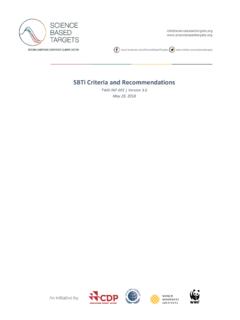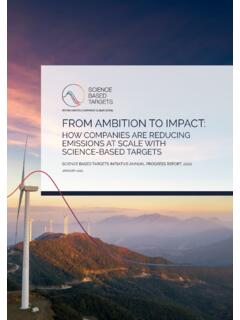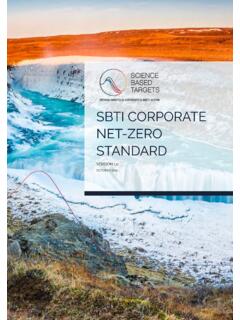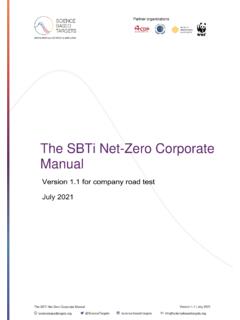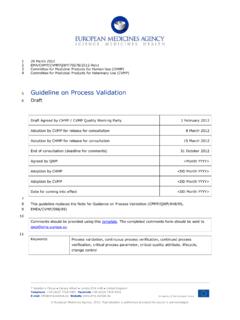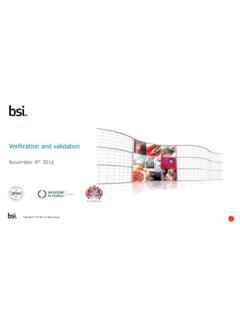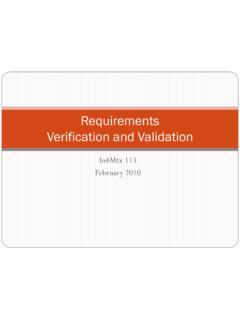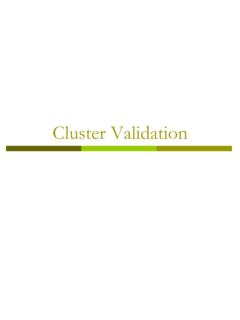Transcription of SBTi Criteria and Recommendations - Science Based Targets
1 Science Based Targets Criteria and Recommendations TWG-INF-002 | Version | October 2021 @ScienceTargets / Science - Based - Targets SBTi Criteria and Recommendations Science Based Targets Criteria and Recommendations TWG-INF-002 | Version | October 2021 @ScienceTargets / Science - Based - Targets Partner organizations Table of Contents Target boundary 4 GHG coverage 4 Scope coverage 4 Emissions coverage 5 Timeframe 7 Scope 1 and 2 near-term Targets 8 Scope 3 near-term Targets 8 Combined Targets 9 Renewable electricity Targets 10 Fossil fuel sales, distribution, and other business 10 Science Based Targets Criteria and Recommendations TWG-INF-002 | Version | October 2021 @ScienceTargets / Science - Based - Targets Partner organizations SBTi Criteria and Recommendations TWG-INF-002 | Version | October 2021 1. Introduction All of the Criteria listed below must be met in order for target(s) to be recognized by the Science Based Targets initiative (SBTi).
2 In addition, companies must follow the GHG Protocol Corporate Standard, Scope 2 Guidance, and Corporate Value Chain (Scope 3) Accounting and Reporting Standard. SBTi Recommendations are important for transparency and best practice, but are not required. These Criteria apply only to companies that are not classified as financial institutions and Small and Medium Enterprises (SMEs). Financial institutions can set Targets using the SBTi Criteria and guidance for financial institutions. SMEs should use the streamlined process to set Targets in line with climate Science . The Target Validation Protocol describes the underlying principles, process, and Criteria followed to assess Targets and to determine conformance with the SBTi Criteria . The SBTi strongly recommends that companies review Table 7 in the Target Validation Protocol that further details SBTi Criteria compliance and non-compliance before commencing target development.
3 Furthermore, SBTi Criteria and Recommendations Version should be read in conjunction with the Target Validation Protocol. While every effort is made to keep companies informed of the latest Criteria and Recommendations , the initiative reserves the right to make adjustments as needed to reflect the most recent emissions scenarios, partner organization policies, and greenhouse gas accounting practices. The initiative also reserves the right to withdraw the validation of an approved target if it becomes apparent that incorrect information was communicated during the target validation process that results in any of the Criteria existing during the assessment not being met, or if requirements following the approval of the target are not respected ( target progress reporting and recalculations). Unless otherwise noted (including specific sections), all Criteria apply to scopes 1, 2, and 3.
4 2. Effective Dates of Updated Criteria This Criteria version will be in effect as of July 15th, 2022. All submissions received by the SBTi prior to July 15th, 2022 can be assessed against Criteria version or Criteria , Recommendations and best practices denoted with an asterisk (*) are refinements and additions to clarifications of pre-existing Criteria and Recommendations . Science Based Targets Criteria and Recommendations TWG-INF-002 | Version | October 2021 @ScienceTargets / Science - Based - Targets Partner organizations 3. Near-term Science - Based Targets and Net-zero Targets Sections I through to VII set out the Criteria specific for near-term target setting. Companies wishing to seek validation for near-term targets1 only may still do so, but the SBTi encourages companies contemplating setting net-zero Targets in the future to consider the implications of the formulation of their near-term Targets for long-term target setting.
5 This document explains the Criteria , which are requirements that companies must follow, and uses precise language to indicate requirements, Recommendations , and allowable options that companies may choose to follow. The terms shall or must are used throughout this document to indicate what is required for Targets to be in conformance with the Criteria . The term should is used to indicate a recommendation, but not a requirement. The term may is used to indicate an option that is permissible or allowable. 1 Near-term Targets were previously termed mid-term Targets . Science Based Targets Criteria and Recommendations TWG-INF-002 | Version | October 2021 @ScienceTargets / Science - Based - Targets Partner organizations I. GHG Emissions Inventory and Target Boundary Target boundary Criteria C1 Organizational boundary: It is recommended that companies submit Targets only at the parent- or group-level, not at the subsidiary level.
6 Parent companies must include the emissions of all subsidiaries in their target submission, in accordance with boundary Criteria above. In cases where both parent companies and subsidiaries submit targets2, the parent company s target must also include the emissions of the subsidiary if it falls within the parent company s emissions boundary given the chosen inventory consolidation approach. Recommendations and additional guidance *R1 Setting organizational boundaries: The SBTi recommends that a company's organizational boundary, as defined by the GHG Protocol Corporate Standard, is consistent with the organizational boundary used in the company s financial accounting and reporting procedures. GHG coverage Criteria C2 Greenhouse gases: The Targets must cover all relevant GHGs as required per the GHG Protocol Corporate Standard. Scope coverage Criteria C3 Scope 1 and scope 2: The Targets must cover company-wide scope 1 and scope 2 emissions, as defined by the GHG Protocol Corporate Standard.
7 *C4 Requirement to have a scope 3 target: If a company s relevant scope 3 emissions are 40% or more of total scope 1, 2, and 3 emissions, a scope 3 target is required. All companies involved in the sale or distribution of natural gas and/or other fossil fuels shall set scope 3 Targets for the use of sold products, irrespective of the share of these emissions compared to the total scope 1, 2, and 3 emissions of the company. 2 This criterion applies only to subsidiaries. Brands, licensees, and/or specific regions or business divisions of a company will not be accepted as separate Targets unless they fall outside of a parent company s chosen consolidation approach. Science Based Targets Criteria and Recommendations TWG-INF-002 | Version | October 2021 @ScienceTargets / Science - Based - Targets Partner organizations Emissions coverage Criteria C5 Scope 1 and 2 significance thresholds: Companies may exclude up to 5% of scope 1 and scope 2 emissions combined in the boundary of the inventory and *C6 - Scope 3 emissions coverage for near-term Targets : Companies must set one or more emission reduction Targets and/or supplier or customer engagement Targets that collectively cover(s) at least two-thirds (67%) of total scope 3 emissions considering the minimum boundary of each scope 3 category in conformance with the GHG Protocol Corporate Value Chain (Scope 3) Accounting and Reporting Standard.
8 Recommendations and additional guidance R2 Targets covering optional scope 3 emissions: Targets to reduce scope 3 emissions that fal l outside the minimum boundary4 of scope 3 categories are not required, but are encouraged when these emissions are significant. This can include Targets to influence the behavior of end-users ( education campaigns) or to drive the adoption of Science - Based Targets on customers ( customer engagement Targets ). Companies may cover these emissions with a scope 3 target, but such Targets cannot count towards the two-thirds threshold defined in C6 for scope 3 emissions ( , these Targets are above and beyond the company s scope 3 Targets ). For reference, consult page 48 in the GHG Protocol Scope 3 Standard and the Target Validation Protocol for a list of products that generate direct and indirect use-phase emissions. II. Method validity Criteria C7 Method validity: Targets must be modelled using the latest version of methods and tools approved by the initiative.
9 Targets modelled using previous versions of the tools or methods can only be submitted to the SBTi for validation within 6 months of the publication of the revised method or the publication of relevant sector-specific tools. 3 Where a company s scope 1 or 2 emissions are deemed immaterial ( under 5% of total combined scope 1 and 2 emissions), companies may set their SBT solely on the scope (either scope 1 or scope 2) that covers more than 95% of the total scope 1 and 2 emissions. The company must continue to report on both scopes and adjust their Targets as needed, in accordance with the GHG Protocol s principle of completeness. 4 For a definition of the minimum boundaries of scope 3 categories and emissions sources that fall outside the minimum boundaries, see Table (page 35) of the Corporate Value Chain (Scope 3) Accounting and Reporting Standard. Science Based Targets Criteria and Recommendations TWG-INF-002 | Version | October 2021 @ScienceTargets / Science - Based - Targets Partner organizations III.
10 Emissions accounting requirements Criteria C8 Scope 2 accounting approach: Companies shall disclose whether they are using a location- or market- Based accounting approach as per the GHG Protocol Scope 2 Guidance to calculate base year emissions and to track performance against a Science - Based target. GHG Protocol requires measuring and reporting scope 2 emissions using both approaches. However, a single and consistent approach shall be used for setting and tracking progress toward a SBT ( , using location- Based approach for both target setting and progress tracking). *C9 Scope 3 screening: Companies must complete a scope 3 inventory covering gross scope 3 emissions for all its emissions sources as set out as the minimum boundary5 of each scope 3 category per the GHG Protocol Corporate Value Chain (Scope 3) Accounting and Reporting Standard. *C10 Bioenergy accounting: CO2 emissions from the combustion, processing and distribution phase of bioenergy and the land use emissions and removals6 associated with bioenergy feedstocks, shall be reported alongside a company s GHG inventory.
